Vivaldi coordinates
Vivaldi Network Coordinates[1] establish a virtual positioning system that has a prime use in networking. The algorithm behind the system uses a distributed technique to estimate propagation times between peers in the network.

Vivaldi plot in the Azureus (Vuze) bittorrent client.
Through this scheme, network topology awareness can be used to tune the network behaviour to more efficiently distribute data. For example, in a Peer-to-Peer network, more responsive identification and delivery of content can be achieved. In the Azureus application, Vivaldi is used to improve the performance of the distributed hash table that facilitates query matches.
Advantages
- Vivaldi is a fully distributed scheme, which achieves good scalability.
- The Vivaldi algorithm is simple and easy to implement.
Drawbacks
- Vivaldi is based on the Euclidean distance model, which requires the predicted distances to obey the triangle inequality. However, there are lots of triangle inequality violations (TIVs) on the internet.
- Lack of security design, very easy for malicious nodes to conduct various attacks.[2]
See also
- Peer-to-peer
- Pharos Network Coordinates
- Phoenix Network Coordinates
External links
- Simulator for Decentralized Network Coordinate Algorithms (NCSim)
- Practical, Distributed Network Coordinates (original paper)
- Azureus Wiki Overview
- Frank Dabek, Russ Cox, Frans Kaashoek, Robert Morris (2004). "Vivaldi: A Decentralized Network Coordinate System" (PDF). Proc. of the annual conference of the Special Interest Group on Data Communication (SIGCOMM'04).CS1 maint: multiple names: authors list (link)
- Mohamed Ali Kaafar; Laurent Mathy; Thierry Turletti; Walid Dabbous (2006). "Virtual Networks under Attack: Disrupting Internet Coordinate Systems" (PDF). Proc. of Conference on emerging Networking EXperiments and Technologies (CoNEXT'06).
This article is issued from Wikipedia. The text is licensed under Creative Commons - Attribution - Sharealike. Additional terms may apply for the media files.